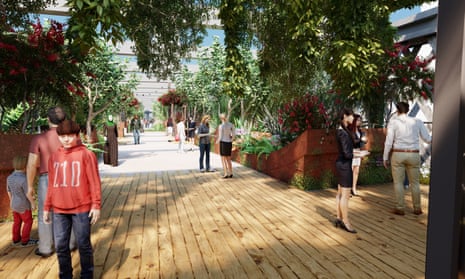A disused Manchester viaduct will transform into an urban “sky park” this summer, providing much needed green space to one of Britain’s least verdant city centres.
The National Trust has begun transforming half of the 330-metre long, 56-arch Castlefield Viaduct into a temporary park that is due to open in July and has been compared to New York’s High Line.

The park will be planted with trees and shrubs, including Manchester poplars, one of the few species hardy enough to survive the pollution of the Industrial Revolution. The herb comfrey will also be cultivated, once used by mill workers to soothe feet sore from hard days in clogs, as well as the cotton flower, Manchester’s county bloom.
There will be raised beds and places to sit, as well as a covered pavilion to provide shelter for those Manchester rainy days, where visitors will be invited to meditate.
Though access will initially be limited to 100 free tickets a day, the National Trust hopes the yearlong project will lead to a permanent public space that will eventually expand and be open to all.
Duncan Laird, head of urban places at the trust, said the scheme could eventually incorporate a traffic-free walking and cycling route between Deansgate and Cornbrook over a mile away – currently a hairy journey by bike or on foot.
For 53 years, Castlefield Viaduct has stood dormant and overgrown, tantalisingly visible to passengers on passing trams and trains but infuriatingly out of bounds to everyone other than the most intrepid graffiti artists.
The Grade II-listed structure was built in 1892 after a period of “railway mania”, in which commercial speculation and competition for routes led to the rapid construction of lines and expansion of the railway network.
By 1939, the bridge carried 11 million passengers and 85 million tonnes of goods a year from Chester and Liverpool to Manchester. The line shut in 1969 with the closure of Manchester Central station, now home to party political conferences, with trains diverted instead to Piccadilly and Oxford Road stations.
Hilary McGrady, director-general of the National Trust, said Covid had highlighted the importance of urban green space. “The pandemic showed us the importance of our local parks and gardens, but it also highlighted significant inequalities in access to green space in urban areas like Manchester,” she said.
“By working with others, we aim to increase access to parks and green spaces in, around and near urban areas, so eventually everyone is in easy reach of quiet places for reflection with wide open skies.”

The trust has raised two-thirds of the £1.8m project cost via public donations and the People’s Postcode Lottery, and will be fundraising for the rest.
The Castlefield Sky Park is part of a renaissance of Manchester’s old railway lines. Several nearby railway arches will soon be turned into Embassy Village, a purpose-built facility for homeless people, while others have become home to breweries and other small businesses.
The rapidly expanding city is notably short of green space, although another urban park, Mayfield, which includes a giant slide, is due to open next year next to Piccadilly.
New York’s 2.3km High Line, completed in 2014, kickstarted a global trend for turning disused railway lines into parks. But while “doing a High Line” has become lazy shorthand for fashioning anything vaguely parklike out of an urban space, the Castlefield Sky Park does follow a similar blueprint, being both high up and on a railway line.
A similar project is in the planning stages in Camden, north London. The Camden High Line will be 1.2km long, about 8 metres above ground, and connect Camden Gardens in the west to York Way in the east.
